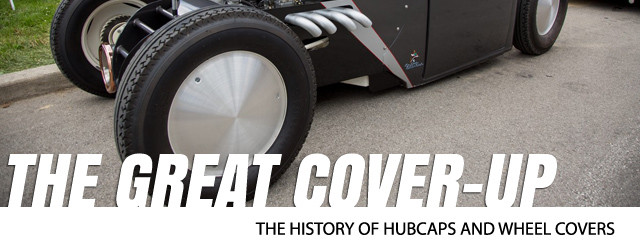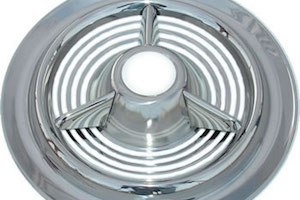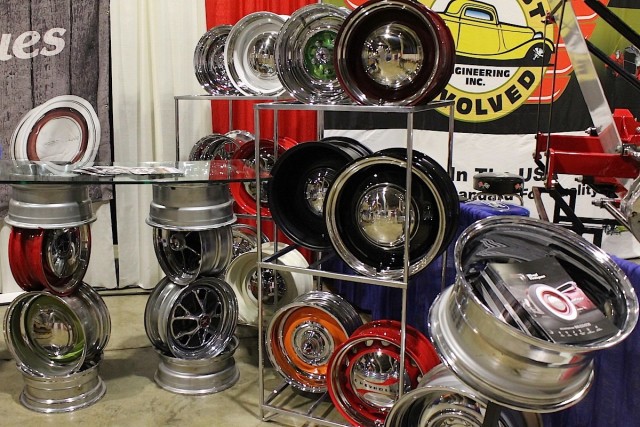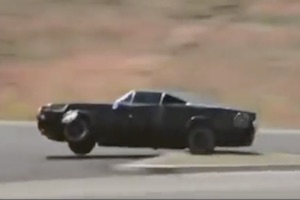We recently added a nice set of Wheel Vintiques smoothies to our project truck, and were stuck with the dilemma of trying to decide whether to leave the wheels bare or put baby moons on the wheel’s center. There are so many different choices in wheel covers, that our mind instantly wanted to know what was common in the past. From there it was a short leap to the history of hubcaps.
The term hubcap has never yielded its top position as the most commonly used term for that thing-a-ma-jig that covers up the wheel of a car. – Mike Collins
Since we’ve mentioned both hubcaps and wheel covers, we wanted to know if these terms were interchangeable, or represented two different things. Why did manufacturers even start using hubcaps and wheel covers? Do they serve a purpose, or wre they just made just to fly off cars in a chase scenes during reruns of the old weekly police dramas? We’ve got the answers to those and much more of the interesting history of hubcaps below.
Hubcap Timeline
- 1680: First used on Newton Reaction Carriages
- Pre-1915: Mostly made of nickel-plated brass
- 1920s: Mostly made of aluminum
- 1927: First snap-on center caps for wire wheels
- 1930s: Spring-loaded retention clip used
- 1938: Full wheel covers introduced
- 1940: Hubcaps expanded in size for function
- 1940s: Dog dish hubcaps featured on base model vehicles
- 1950s: Lack of hubcaps represented in drag racing
- 1960s: Stainless steel full-spoke wheel covers introduced
- 1970s: Plastic wheel covers introduced
- 1980s: ABS wheel covers replaced steel hubcaps on all cars
How and why did hubcaps come into existence? Did the Detroit automaker Gods come down from the mountian one day uttering “Let there be hubcaps,” or is there a simpler and more functional explanation? According to Hubcap Mike, “Originally, there was a functional necessity for the cap,” he said. “At first, autos were made with wooden spokes like a buggy or wagon wheel. The wooden spokes connected the outer steel rim to the center hub, which contained the wheel bearing. The wheel bearing was packed with grease,” Mike continued. “Something was needed to cover the center hub which could keep the dust out, and the grease in.”
It was clear that a cap was needed to cover the hub and protect the wheel bearing. This cap could have easily been called a dust cover but the original caps were small and purpose-built. Hubcap was an obvious choice in nomenclature.
Changing Times
As luck would have it, wooden spoke wheels did not last long in the automotive world. They would come from the factory heavily varnished, many times with decorative pinstriping. Unfortunately, they would quickly age and crack when exposed to the elements. “You could always hear, even from a great distance, a car with aging wooden spoke wheels,” said Mike. “The creaking sounds as they drove down the road were a dead give away.”
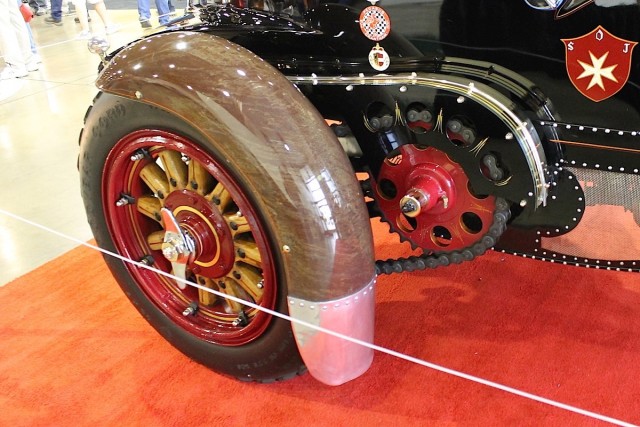
Even wood spoke wheels had covers over the center hubs. In this case, the cover is held in place by a “knock-off” spinner.
Hubcap Mike explained that steel wire-spoke tires came on the scene in the late 1920s and early 1930s, replacing the wooden spoke wheels. These new wheels also needed center caps over the hub, “Which still left the steel, welded-wire spokes exposed,” Mike added.
In the 1930s, when the country’s economy was struggling, function gave way to style and decoration in luxury vehicles. Hubcaps became larger and were made of either brass or stainless steel, and featured the auto manufacturer’s name. These were utilized as a decorative design feature, but still covered only the wheels hub. The wire spoke wheels presented a problem, as they were hard to keep clean and made an annoying wind noise as the cars would go down the street.
What Does A Hubcap Do?
Hubcaps serve a number of different purposes on cars, some aesthetic, while others are functional.
The functional purpose, and reason for the invention, is to protect the wheel hub. Environmental exposure to heat, salt, dirt, and moisture can cause wear and corrosion that will act on lug nuts or bearings. Installing a wheel cover or hubcap will help minimize those hazards.
A humble, pressed-steel wheel can be pretty homely. Usually painted flat black or silver from the manufacturer, these wheels can be visually enhanced with an attractive set of hubcaps.
Hubcaps are less expensive than buying a new wheel. Cars that are driven in the harsh winter environments and deal with salty road grime, may benefit from an easily replaced wheel cover or hubcap rather than buying a new wheel to replaced a tarnished, old, weather-beaten one.
In 1934, Cadillac fitted its new model with a stainless steel disc, which was held in place by the screw-on center hubcap that fit over the top of the disc. The disc actually covered most of the wheel, completely covering the wire spokes. This new styling feature gave the wheel a luxurious, streamlined appearance.
Following Cadillac’s lead, Cord and Hudson also began to use wheel covers on their new models. Cord’s wheel covers were plain chrome with a smooth top and holes on the side. Hudson took advantage of the flat cover by imprinting the words Hudson, Hudson Eight, or Terraplane on their wheel covers.
The term wheel cover was used in advertising and merchandising in 1938, when Cadillac began using pressed steel wheels that are similar to the wheels used today. The manufacturer covered the wheels with full-sized hubcaps they called wheel covers.
“Despite being the latest and greatest thing out of Detroit, the term hubcap has never yielded its top position as the most commonly used term for that thing-a-ma-jig that covers up the wheel of a car,” Mike stated. This may be true, but we think there might be some bias against wheel covers when you go by the name “hubcap Mike.” The important part of this story is that Cadillac made the full-sized wheel cover a symbol of luxury and class. Other, more economical car brands came with simple and inexpensive hubcaps that were referred to as “dog dish” caps because of their size and shape.
Hot Rodders & Hubcaps
It wasn’t long after the ‘big war” when hot rodders began to seek out the old Cadillac wheel covers for their 1930 through 1950’s custom rods. Hubcap Mike explained, “Probably the most classic Cadillac hubcap was the heavy, brilliantly-chromed 1950 wheel cover, nicknamed the Sombrero because its profile resembled a sombrero hat,” said Mike. “Cadillac owners soon began to realize that their hubcaps were very much in demand. They would usually figure this out when they would go to get in their car and happen to notice that they no longer had any hubcaps.”
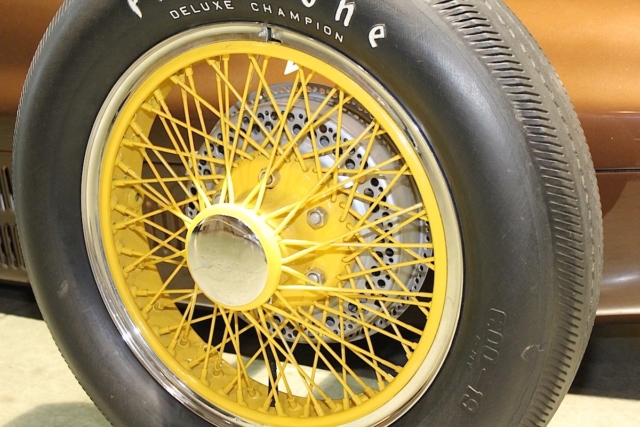
Wire-spoke wheels had a small center cover hubcap to protect the wheel bearings from dirt and grime.
The Moon hubcap, which became popular in the fifties, is often considered a racing hubcap. “Interestingly enough, the first spun aluminum Moon wheel cover was not invented in the fifties,” Mike pointed out. “Bob Rufi, the fastest man alive in 1940, used spun aluminum hubcaps from, of all things, a WWI Jenny war plane to help streamline his 140 mph record breaking speed machine at the Bonneville Salt Flats.”
Hot rodding and drag racing walked hand-in-hand during this time, with the early drag racers souping up their cars on the weekends to drive to the drags. As the racing got faster and more competitive, safety issues became a concern. “Hubcaps had a nasty habit of flying off and giving unprepared spectators a new “part” in their hair,” said Mike laughingly. “New rules were instated that required racers to remove their hubcaps before racing. This was for safety reasons and also for proper inspection of the wheels.”
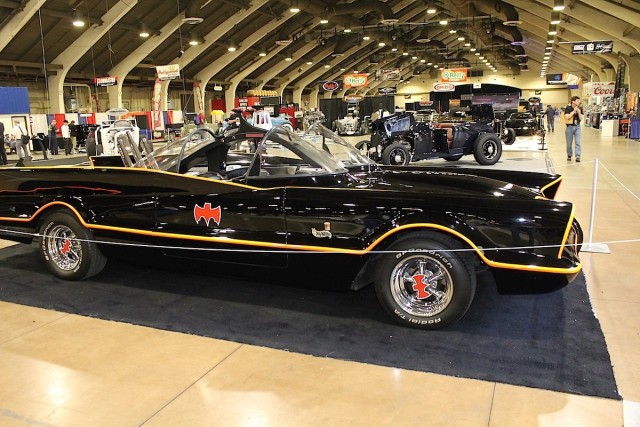
In more modern times, center hubcaps featured logos or car manufacturer names. Many of these became iconic symbols of certain cars. The Batmobile would not look the same without the signature batman logo hubcaps.
Because of the new rules, racers began leaving their hubcaps off, and driving to and from the drags. They even started driving around town like that. In short order, seeing a car with no hubcaps came to mean it was a drag racer. “Drag racers began painting their wheels and decorating them with chrome lug nuts and chrome dust covers,” Mike added. “Some believe this led to chrome wheels, followed by the mag and aluminum wheels which became very popular in the sixties.”
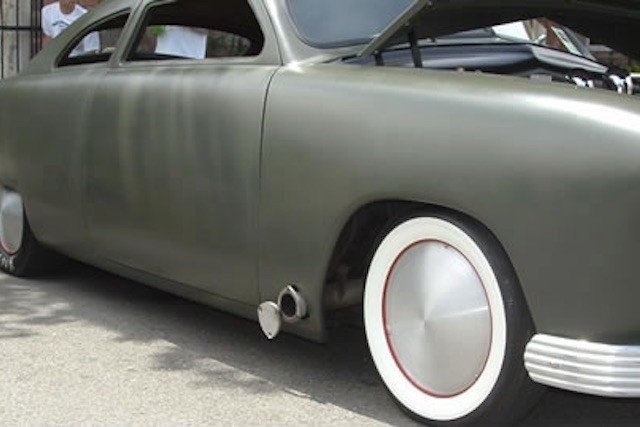
Many of these wheel covers or hubcaps came from the racing world and infiltrated popular car culture. Nothing said speed like the aluminum moon hubcaps on dry lake or Bonneville cars.
The 1970s And Plastic
Manufacturer’s began using ABS plastic hubcaps on their new models in the 1970s. The finish of the hubcaps made them look like chrome or brushed aluminum, but they were less expensive to produce. By the 1980s, ABS plastic had virtually replaced all steel hubcaps on cars coming out of Detroit.
Why Hubcaps Fly Off
Wheels, especially pressed steel wheels, often flex when a vehicle is driven very hard. When the wheels flex, so does the mounting points of the wheel cover and hubcap. Likewise, hitting potholes or curbs, or hard braking can flex the wheel enough to have the wheel cover or hubcap depart the wheel.
Mike clued us in on the best lesson in hubcaps: “Being sturdy, rugged and light alone is not enough. The wheel cover needs to have a good solid retention system,” he said. “The best is an all steel 360 degree retention ring that can really grip the steel wheel and help the hubcap stay on.”
Hubcups are part of what makes our hobby great, and a great-looking wheel with the right hubcap can make or break a project build. There is little chance that car enthusiast or hot rodders will ever end the running love affair with these great functional devices. For more information on hubcaps or help in finding the right hubcap, visit Hubcap Mike online at www.hubcapmike.com.



